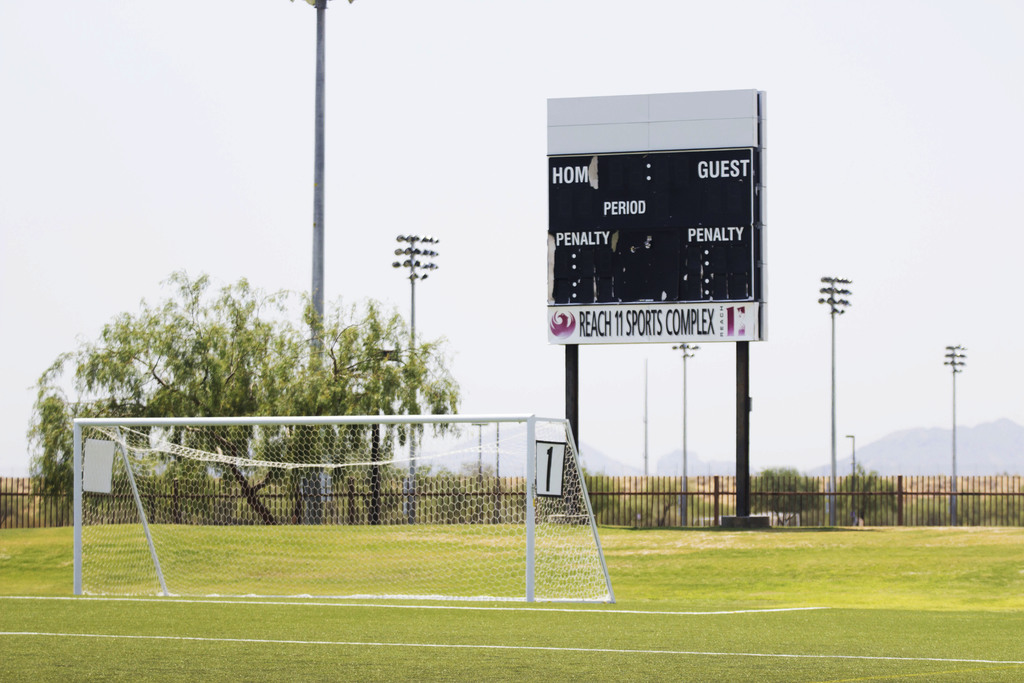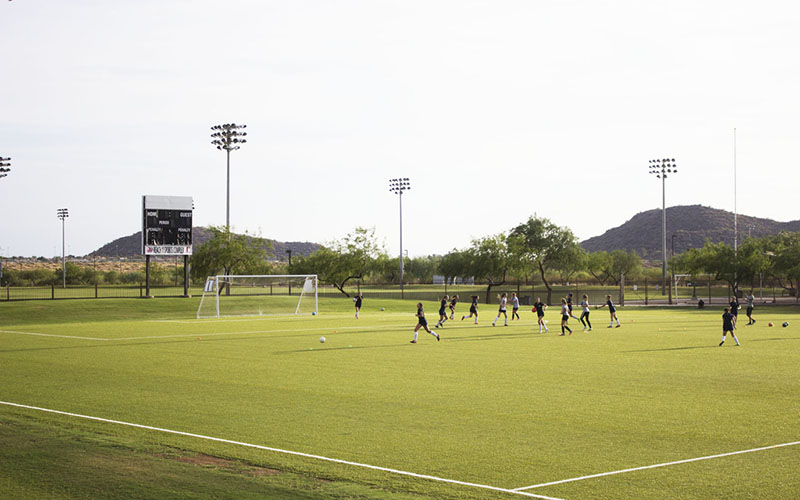Aug. 4, 2017
PHOENIX – Every February, hundreds of teams and thousands of spectators from around the United State converge on the Reach 11 Sports Complex in northern Phoenix to compete in one of the largest soccer tournaments in the country.
With more than 400 teams, the President’s Day Tournament has established itself as one of the premier club soccer events in the nation, along with the Dallas Cup in Texas and the Surf Cup in Southern California – and that attracts college coaches and recruiters.
“I have been down here every February for probably 15 years, probably even more than that, recruiting at that event,” said Grand Canyon University assistant men’s soccer coach Kevin Doyle, who recruited for Air Force, Virginia Tech and Creighton before coming to GCU. “We primarily focus our recruiting efforts on club events. It’s a lot more efficient. You have one of those events where there’s a couple hundred teams in town that are made up of good players.”
Massive club tournaments in a variety of sports pit the top athletes against each other and draw top recruiters, but participation can cost families thousands of dollars a year, potentially putting the important pathway to a college scholarship out of reach of those who cannot afford the fees and travel expenses.
Gilbert High School twins Danny and Robby Baca have played for Phoenix soccer club Sereno for the past seven years. In February, the two brothers signed to play soccer at Fort Lewis College in Colorado. Danny said he received a lot of scholarship offers from Division I colleges and doesn’t think he would have if he didn’t play club soccer.
“Most of my looks and offers came from club,” Danny said. “It is a very good way of showcasing yourself in front of these coaches while they are there, so I believe that it is very beneficial.”
Their father, Pat, said the family paid about $6,000 per year in fees and travel expenses. They made multiple trips to cities like Dallas, Denver, Southern California and Las Vegas. In the end, Baca said it paid off for his twins.
“We feel the expense is just a temporary thing and since we’ve got it, we might as well share the wealth when we can,” Baca said. “Were there sacrifices on our end? Certainly. Did we forego certain things or vacations because of club soccer? Absolutely. But, those tournaments became our vacations.”

Reach 11 Sports Complex in northern Phoenix has 18 soccer fields. The complex is home to SC del Sol’s President’s Day Tournament every February. (Photo by Greg Macafee/Cronkite News)
The Baca’s were able to afford the club and tournament fees and often helped other players on the team when their parents could not afford to travel. That’s not always the case for players who can’t afford to play club soccer, but many clubs do offer scholarship opportunities.
“What we do probably more than anyone else is we break it down to the team,” said Sereno executive and technical director Brent Erwin of their scholarship program. “We break it down so that each team is able to provide opportunities for kids. Sometimes you picture financial as being a downtrodden, but everyone goes through challenges. Everyone goes through good times and bad times. So we try to be there and be flexible and be able to help people when they need it.”
Sereno is affiliated with the Major League Soccer team Real Salt Lake and on occasion receives help from the organization. In the past year, Erwin said that Sereno has spent more than $50,000 in scholarship money.
They are not the only club to follow this philosophy. SC del Sol executive director Mark Lowe said the club’s scholarship fund totaled $140,000 in the past year and is awarded based on need, not just ability.
Other clubs offer different options to make sure money isn’t a problem as well. Chicago based club, F.C. United, travels more than 1,700 miles every year to compete in the President’s Day Tournament. Senior boys director Baer Fischer estimated that the cost was $600-$700 per player for travel costs, accommodations and the tournament fee.
“We make sure that every player is included,” Fischer said. “When you join our club there is other avenues you can take if you can’t afford it. Players can fundraise, they can work it off at the club, there’s opportunities to ref for the younger teams games or helping out at the indoor facilities. We always find a way to make sure every player attends.”
Playing club soccer doesn’t guarantee that athletes are going to be able play at the next level, but it does increase a player’s chance of doing so. According to NCAA.com, 86 percent of student-athletes played club soccer before moving on to the collegiate level. That percentage of participation in club sports was consistent across sports with a large club scene.
In sports like football, where a club scene is almost non-existent, athletes primarily played just high school football. According to the same study by the NCAA, 75 percent of collegiate football players played just for their high schools, while only 23 percent played both high school and club.
In football, because of the lack of a club scene coaches are stuck traveling to high schools on a consistent basis to scout players individually. But in sports like soccer, basketball, and baseball, coaches have the ability to see multiple players in one day at major tournaments. Doyle said that’s one of the reasons that even though he will still scout at high school games, scouting at large tournaments is more efficient.
“As a Division I program, the kids that we focus on are the top players on their teams,” Doyle said. “So, these club teams are comprised of the top players from the high school teams and once again, it’s more efficient for our time. We could spend every minute of our day out recruiting, and watching games, but I wouldn’t have a wife anymore if I did something like that.”
Club teams don’t just provide the opportunity for players to play in front of college coaches, they also conduct off-the-field work as well. Lowe employs a college advisory program that puts players in touch with colleges around the country. Sereno offers both academic advisement and college placement advisement for the soccer portion as a part of their organizations.
“The new side we’re bringing in is that we’re providing SAT and ACT prep, as well as helping athletes with class selection for college,” Erwin said.
The goal is to put together the top club that can compete at an elite level and send its players to the next level, which in turn attracts the next crop of athletes.
“The thing that’s going to get you into college is if you’re not good with the books, you aren’t playing college sports,” Lowe said. “Second, as well as being bright, you have to be a good soccer player. And if you’re not a good player, it doesn’t matter how much you pay me if you’re not bright and if you’re not a good player I can’t get you into college end of story, and we make that very clear to all our players.”


Leave a Comment
[fbcomments]